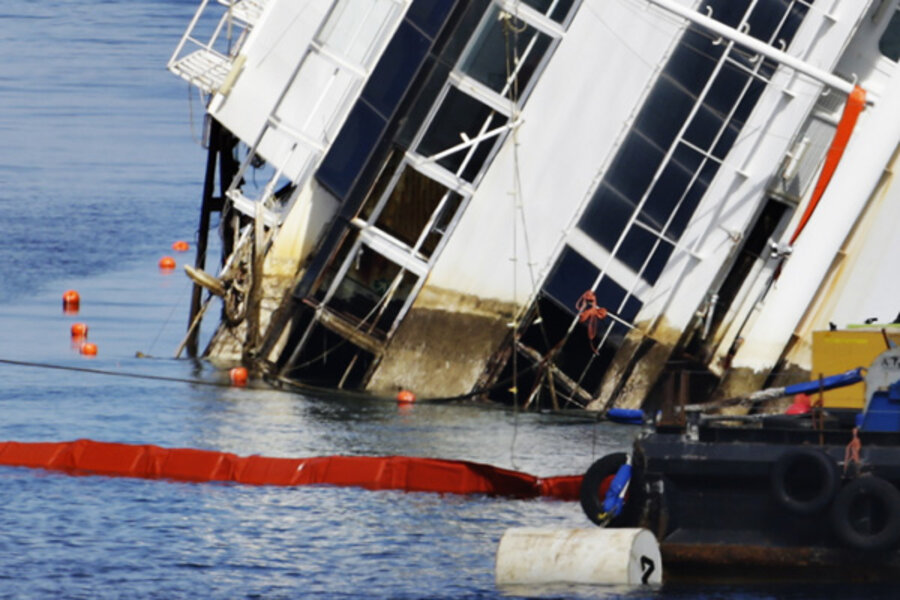Costa Concordia: mammoth salvage effort could break records – and the boat
Loading...
| Giglio, Italy; and Paris
As the colossal Costa Concordia cruise ship is raised from the waters off the Italian island of Giglio, engineers are bearing witness to the most complicated task of its kind in maritime history.
The 114,500-ton vessel, which capsized in January 2012, killing 32 people, is twice the size of the Titanic. And turning it upright to haul it to land has never been tried before with a vessel this size and so close to the shore.
The operation has been eyed by environmentalists, who worry that a toxic waste spill could pollute the Mediterranean waters around the island. It has also raised eyebrows for its price tag: 600 million euros and counting, in an age of austerity.
The lifting of the vessel is expected to take all day today, and engineers have already reported that they successfully separated from ship from the reef on which it has been lying. Hopes are high that the salvage effort will not cause the boat to break apart in the process.
For the residents of Giglio, the operation is the first sense of closure they have felt – and one they say they desperately need.
“Every time we see it lying there, we think of that terrible night – all the people standing wet and cold and bewildered in the harbor after making it ashore, and the 32 people who died,” says Renato Iacovacci, an islander who was walking his dog down a narrow lane overlooking the rust-streaked ship Monday. “There is still great sadness on the island, but we hope that will begin to heal once they raise the ship and make plans to remove it once and for all.”
The giant leisure liner, which boasted four swimming pools and the world's largest ship spa, hit rocks just offshore Giglio in January after veering toward it in what has been characterized as a show-off stunt by its captain, Francesco Schettino.
The boat capsized just yards from Giglio’s rocky shoreline, right in front of the entrance to the island’s main port, a picturesque harbor crammed with fishing boats and lined with pastel-colored homes of shuttered windows and brightly painted doors.
The vessel, which has been lying on its side for nearly two years, has blighted the once-touristed island. While locals say there has been a sharp increase in the number of “disaster day-trippers” – tourists who take the ferry from the mainland of Tuscany to the island to have a look at the wreck for a couple of hours, before returning – there has been a decrease in the number of tourists spending a week or two on the island.
The challenges of the rescue efforts are manifold, ranging from loose cutlery in the waters to fridges full of milk and eggs and other now rancid substances that could escape during the effort. (See a video here by CNN about what the shipwreck looks like from under the water.)
Lifting the Costa Concordia will take some 12 hours.The length of the ship, at 951 feet, is about three times the length of a US football field. More than 50 chains have been attached to secure the ship. Once it is hauled upright, it will be rolled onto an artificial seabed consisting of six giant steel platforms and hundreds of sacks filled with cement.
Those sacks will have to be removed after the operation is completed, along with pylons, cables, winches, and jacks used to lift the ship. The goal is to eventually restore the seabed to as close to its pristine state as possible.
Residents say they have faith the mission today will be successful. “We’re optimistic, although we know that there are risks. But we can’t wait for the ship to be raised and towed away,” says Aldo Bartoletti, from Giglio’s council.
More than 4,200 passengers from 70 countries were onboard at the time of the accident, which happened at dinnertime on the first night of the cruise. And it is the family and friends of the victims who are most touched by the operation today.
The body of Elio Vincenzi's wife, Maria Grazia Trecarichi, a passenger from Sicily who was on the cruise to celebrate her 50th birthday, is believed to be in the wreckage still. Mr. Vincenzi says he bears no hatred towards Mr. Schettino, whom the nation has dubbed “Captain Coward” and who faces charges of manslaughter, causing a shipwreck, and abandoning ship in a closely watched trial that started in July.
But he does want more information. “I don’t feel hate or rancor. I just want to find my wife’s body, to bury her in Sicily and to know what happened in those last minutes,” he told La Repubblica newspaper.
Final closure, however, will not come for months. The lifted ship will be stablized in the next few weeks but will remain off Giglio for the winter, as the storms that buffet the island make the task of removing it too perilous. It will not be towed away until next spring at the earliest. Officials plan to tow it to an Italian port – possibly on the coast of Tuscany – where it will be broken up for scrap. While the total cost of the salvage operation so far stands at 600 million euros, the cost is likely to rise much further.







